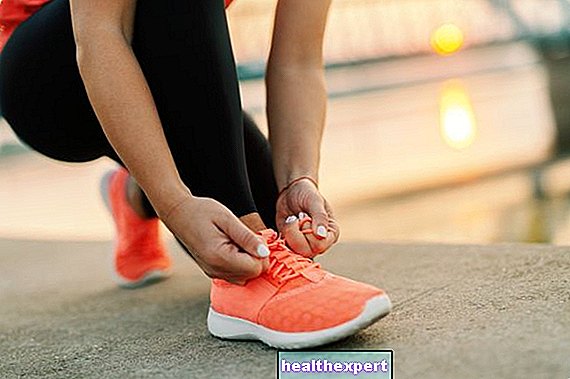Start running: tips and training program for new runners
Losing a few extra pounds, having an "excuse" to stay more outdoors or simply adding a good and healthy habit to your lifestyle: the reasons to start running are many and vary from person to person, but, although running is a sport that "always welcomes everyone", it is necessary to approach this activity correctly. Today we discover some tips for those approaching the world of running for the first time, seeing in detail what are the benefits of " run and also what is the right program for beginner runners to follow.
But first, take a look at this video: did you know that some zodiac signs are more predisposed to certain sports than others?
Why start running
The reasons that push to approach the world of running change from case to case, vary according to the years and age and for the most varied personal reasons. Of course, however, running has a series of benefits and advantages that cannot First of all, since this sport helps to activate the metabolism, it allows you to burn fat quickly, as long as it is combined with a healthy and balanced diet that allows you to lose or maintain the desired weight.
In addition, several studies have shown that running is one of the activities that releases the greatest amount of dopamine and endorphins, hormones of well-being that provide an immediate feeling of fulfillment and happiness. The result? The levels of anxiety and stress are significantly lowered, counteracting the risk of depression.
Finally, like all other sports, running helps to "disconnect the brain". It has been demonstrated that it makes its own the ability to create a mental vacuum, helping to drive away negative thoughts and to concentrate one's energies on the body, finding in moments of crisis the strength - all mental - to go beyond our body.
Therefore, whatever your goal in this discipline, or whether you want to start and continue as an amateur or reach important goals later, run and you will see that all these benefits will give you an "additional charge and motivation!
See also




What it takes to run
Unlike many other sports, running doesn't require an inordinate amount of specific equipment. What is important is to get a good quality running shoe. In fact, as confirmed by professional runners, the main investment for this activity coincides precisely with shoes.
Especially when you are just starting out, it is essential to let yourself be guided and advised in the purchase of the shoe by the opinion of an expert. Running shoes vary according to the weight of the wearer and their structure.Normally, you have to buy them at least one number more than the normal one, since the feet swell after a while you run. Plus, we don't all run the same way, because we tend to place our foot differently. We recommend that you follow the advice of an expert, so that they can also give you a test on a treadmill to understand which shoe best suits your stride and your build.
Other than shoes, you need little else. The rest of the clothing consists of sports bras, trousers - or shorts for the warmer months - elasticated, T-shirts and jackets for autumn and winter. The important thing is that all clothing is made of breathable material, avoiding garments. fleece or cotton that do not let the skin breathe during training.

A few basic techniques and rules for beginners
No, being an individual sport, unless you join a group, there are no rules for which you risk being eliminated. However, if you are approaching running from scratch, it is good that you keep in mind some tips and techniques to be able to start and continue your training in a correct and safe way for your health.
1. Password "graduality"
As often happens when starting a new thing, we get caught up in euphoria and we would like to do everything immediately, obtaining good results immediately. As a beginner runner, forget all this: for the first weeks of training the key word will be, precisely "graduality" Indeed, professional runners recommend starting first with walking moments alternating with a minute or two of running, and then gradually increasing the time you run, decreasing the time you walk proportionally.
Also, forget about speed for a few weeks. The important thing in the first few days of training is to "build" your breath and start working on endurance. The quick sprints and speed will come by themselves with time, but don't rush things.

2. Warm-up and correct posture
Although the fact of running may appear as a natural and instinctive gesture of your body, in reality it requires some precautions to avoid having problems in the back and legs over the years.
First of all, you must warm up before starting the workout: loosen your ankles by rotating your foot with the toe on the ground, clockwise and counterclockwise, also relaxing your torso and arms. Then, start running with a natural stride, trying not to strike the heel when the foot is in the push-up position. The forward thrust must be given by the fingertips to avoid creating too many bumps at the height of the back and pelvis.
Finally, the arms should never be left dangling along the body. They follow the natural rhythm of your movement by standing tall and loose next to the torso, following the thrust of the legs.

3. Never forget about stretching
Just as the warm-up phase is important before the actual run, in the same way we must never neglect the stretching at the end of the workout. Experts suggest at least 5 to 10 minutes of stretching, depending on the time and distance traveled. The cool-down must be concentrated above all on the legs, doing exercises both standing and on the ground that help to loosen the muscles after physical exertion, but it is also good to make movements for the loosening of the upper limbs, such as lifting the arms above the head , breathe deeply and then release them along the body.
On non-running days, spend some time doing some core stablity, which tone and strengthen the muscles, such as those aimed at the abdominals.

4. Consistency is everything
It is useless to hide it, at the beginning running is an effort. Taking your breath away and building up stamina do not happen immediately and require motivation and discipline. For this reason, more than great physical qualities, in the first days of training a gift will be central: constancy. Try to go out regularly - but don't overdo it! - and to follow your schedule without letting yourself go to laziness or giving in to the thought "not to make it". Many people find it helpful to join a group of runners or find a friend to hang out with so as not to succumb to the temptation of staying home and postponing the training session to another time. Others, on the other hand, find it effective. keep a notebook where you can write down all the progress you have made and thus find the right energy to go for a run every time!
Whichever solution you think is most valid for you, give yourself time and you will see that the results begin to show.

5. Pay attention to the power supply
Running requires a great deal of energy and fluids. After a workout there is a need to load carbohydrates and water again, even through supplements - there are various formats on the market, even in gels. However, this does not mean that going for a run allows you to eat anything. sooner or later. The "diet to follow must" always be healthy and balanced, but obviously you can allow yourself a few exceptions to the rule every now and then, especially after you have obtained a good result!

Training program for the first weeks of running
We conclude with a preparatory program for new runners, who approach running from scratch. This is a 10-week table, with 3 exits each, which aims to run continuously for an hour or 10km. It is strongly not recommended to go out twice in a row, leaving at least one day of rest between one workout and another.
Finally, we want to clarify that it consists of a purely indicative program and we strongly recommend that you consult your doctor before starting any training, to enjoy the beauty of running without stress!
Week 1
Day 1: 1 minute of light running alternated with 2 minutes of walking 9 times (tot. 27 minutes)
2nd Day: 1 minute of light running alternated with 2 minutes of walking 9 times (tot. 27 minutes)
Day 3: 2 minutes of light running alternating with 1 minute of walking 8 times (tot. 24 minutes)
Week 2
Day 1: 2 minutes of light running alternating with 3 minutes of walking 6 times (tot. 30 minutes)
2nd Day: 2 minutes of light running alternated with 2 minutes of walking 4 times (tot. 24 minutes)
Day 3: 2 minutes of light running alternating with 3 minutes of walking 6 times (tot. 30 minutes)
Week 3
For all three days: 4 minutes of light running alternating with 3 minutes of walking 5 times (tot. 35 minutes)
Week 4
For all three days: 6 minutes of light running alternating with 3 minutes of walking 5 times (tot. 45 minutes)
Week 5
For all three days 10 minutes of light running alternating with 3 minutes of walking 4 times (tot. 52 minutes)
Week 6
For all three days: 15 minutes of light running alternating with 3 minutes of walking 3 times (tot. 54 minutes)
Week 7
For all three days: 25 minutes of light running alternating with 3 minutes of walking twice (tot. 56 minutes)
Week 8
Day 1: 40 minutes of light running.
Day 2: 40 minutes of light running.
Day 3: 45 minutes of light running.
Week 9
Day 1: 45 minutes of light running.
Day 2 :: 50 minutes of light running.
Day 3: 50 minutes of light running.
Week 10
Single exit: 1 hour of light running or 10 km.